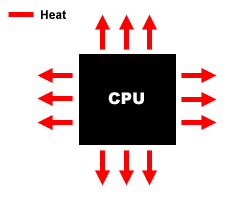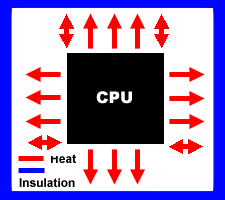Alternative Cooling at its Best
by Anand Lal Shimpi on October 24, 1998 2:46 PM EST- Posted in
- Cases/Cooling/PSUs
| The key to a successful cooling system is realizing your goal. For the purpose of overclocking, defining a "successful cooling system" depends directly upon the success of your overclocking experiment. This article will concentrate on an average overclock for this sort of cooling, nothing like the 333MHz to 450MHz overclock which Kryotech accomplished, rather something more in the middle. With your processor constantly producing heat, the problem or goal is to remove as much of that heat as quickly as possible therefore keeping your processor free to produce even more heat without any adverse effects on the stability of your system. While that seems relatively simple, it requires a perfect understanding in order to pursue the construction of the rest of the cooling system. |
|
Isolating the Problem
| In order to properly cool any single device, one must isolate it from all other sources of heat in its surroundings. This means, enclosing the CPU in some sort of a capsule. The stipulations for this capsule dictate that it must be a well insulated capsule, in that it should be a poor thermal conductor so we keep the heat inside of the capsule. Make an opening in the capsule and what do we get? An intake valve. By allowing a coolant to flow into the intake valve, in the most simple of terms this coolant could be water, it flows over the surface of the CPU therefore replacing the air in the capsule as a conductor of heat. By definition water is a much better conductor of heat and therefore works much more effectively at carrying the heat away from the processor than air itself. What do we do once the water has absorbed the heat from the processor? |
|
| Well, make another opening in the capsule and we've got ourselves a handy little outtake valve. By channeling the heated water through that opening, the heat is effectively removed from the processor and our goal accomplished. | |
The tubing being fed to the intake and outtake valves must be insulated as to keep the heat and the coolant as hot and cool as possible while inside the case of your system. You definitely don't want to lose any heat to other components in your system which would introduce new possibilities for instability, and if you want to overclock you sure don't want to lose any of your coolant to the air in the system case. We'll wait until we're out of the case to worry about getting rid of the heat. Possibilities for tubing material include plastic, vinyl, or other such materials as they provide generally decent insulation for the type of problems we'll be introducing.
What have we accomplished so far? We've defined our goal, established a way of introducing a coolant to the processor, removing heat, and channeling it away, however what do we do with that heat and how do we add closure to this system of ours? Keep on reading...












0 Comments
View All Comments